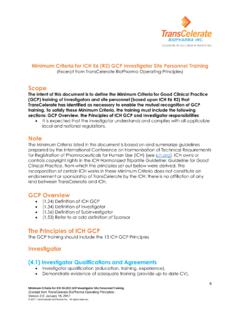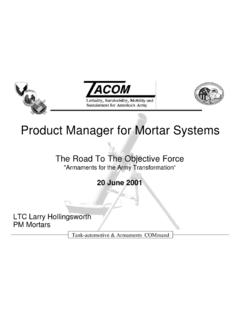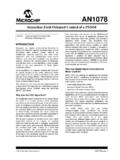Transcription of Position Paper: Risk-Based Monitoring Methodology
1 2013 TransCelerate BioPharma Inc. All rights reserved. Position paper : Risk-Based Monitoring Methodology 1. Abstract Current On-site Monitoring practices are frequency- based , conform to a prescribed Monitoring visit schedule, and provide generalized quality control at investigational sites. Although this practice does provide a level of control, advances in Risk-Based approaches and technology provide an opportunity for a more holistic and proactive approach through Off-site and Central Monitoring and a targeted approach to On-site Monitoring . By building quality and risk management approaches into the scientific design and operational conduct of clinical trials, risks can be mitigated and issues can be detected early or prevented entirely. TransCelerate BioPharma Inc. (TransCelerate) developed a Methodology that shifts Monitoring processes from an excessive concentration on Source Data Verification to comprehensive risk-driven Monitoring .
2 This philosophical shift in Monitoring processes employs Centralized and Off-site mechanisms to monitor important study parameters holistically and uses adaptive On-site Monitoring to further support site processes, subject safety, and data quality. 2. Introduction Over the last decade, the complexity and cost of clinical trials has increased dramatically. Despite advances in the digital revolution, the pharmaceutical industry s productivity has Current operational practices used in clinical trials are expensive and do not guarantee data quality. Through modernization, including use of technology enablers, efficiencies can be gained without impacting subject safety by implementing quality risk management approaches to clinical trial The pharmaceutical industry has traditionally relied heavily on On-site Monitoring approaches, including significant amounts of Source Data Verification (SDV) to help ensure subject safety and generate quality data.
3 It is a reacti ve approach, limited in its ability to quickly identify issues and prevent them from recurring. Further, this resource-intensive approach is applied uniformly throughout a trial rather than proportionate to risks . Since intense On-site Monitoring does not guarantee identification of all subject safety or data quality issues, the associated high costs are disproportionate with the value gained. Therefore, there is movement within the industry (eClinical Forum3) driven by health authorities (HSP/BIMO Concept paper 20074; Food and Drug Administration [FDA], FDA Draft Guidance 20115; European Medical Agency [EMA], EMA Reflection paper 20116; MHRA Risk Adapted Approaches7) to transition to Risk-Based Monitoring . Several initiatives are underway to promote Risk-Based Monitoring (RBM) paradigms. The Clinical Trials Transformation Initiative (CTTI) identified practices to increase the quality and efficiency of clinical CTTI advocates building Quality by Design (QbD) into clinical trials, starting with protocol development and extending across all aspects of a trial.
4 Quality refers to the ability to effectively and efficiently answer the intended question about benefits and risks , while assuring subject safety. Position paper : Risk-Based Monitoring Methodology 2 FINAL 30 May2013 2013 TransCelerate BioPharma Inc. All rights reserved. Decisions are supported by quality data which is not considered error-free data, but rather fit-for-purpose data that sufficiently supports conclusions equivalent to those derived from error-free QbD includes a focus on key risks to subject safety and data quality, developing a quality risk management plan that focuses on factors that are at high risk for generating errors, and applying an efficient Monitoring approach to rapidly detect and correct issues while the study is ongoing. A quality risk management plan should be created during study planning, and be reviewed and amended throughout the trial to mitigate risks .
5 Monitoring strategies, tailored to risks , should permit timely oversi ght and be focused on Critical Processes and Critical Data. Notably, Investigators are responsible for their site s data quality and are expected to partner with the Sponsor to address, resolve, and prevent issues. TransCelerate BioPharma Inc. (TransCelerate) is a non-profit organization comprised of pharmaceutical and biotechnology companies collaborating to create transformational process improvements that will help ensure safe and effective therapies are brought to market more efficiently. TransCelerate developed a standard approach for RBM that can be adopted for any type, phase (Phase 1 through Phase 4), and stage of trial. The TransCelerate RBM Methodology improves efficiency by changing the focus to Central or Off-site Monitoring activities that are intended to identify potential issues sooner than a Monitoring strategy that relies primarily on site Monitoring visits.
6 TransCelerate member companies are piloting the Methodology on various types of trials. Lessons from these pilots will inform and evolve the RBM Methodology , as needed. TransCelerate s RBM Methodology uses quality risk management as a foundation in ensuring subject safety and data quality through the implementation of the following: (1) building QbD into trials, (2) early and ongoing risk assessment, (3) a focus on Critical Processes and Critical Data, (4) use of Risk Indicators and Thresholds, and (5) adjustment of Monitoring activities based on the issues and risks identified throughout the study. By Monitoring available data Off-site or Centrally, On-site Monitoring can be targeted to activities that cannot be assessed remotely. Additionally, TransCelerate has adopted the term Source Data Review (SDR) that describes review of source data for protocol compliance, quality of documentation, as well as site processes in contrast to transcription checking, referred to as Source Data Verification (SDV).
7 The TransCelerate RBM Methodology is aligned with the QbD paradigm, and with the Monitoring and study oversight expectations of health authorities. When RBM methods are used, applicable ethical standards, subject rights, laws and regulations are expected to be followed. Further, TransCelerate s Methodology is being developed concurrent with the transition to Risk-Based inspection processes by health ,6 Retrospective Analysis of Monitoring and SDV To better understand the impact of existing SDV approaches on overall data quality, TransCelerate member companies evaluated data discrepancies for completed studies to determine the rate of queries identified via SDV as compared to all queries for a study, and then further assessed those queries to determine what percentage of SDV-generated queries were found in Critical Data.
8 Position paper : Risk-Based Monitoring Methodology 3 FINAL 30 May2013 2013 TransCelerate BioPharma Inc. All rights reserved. Nine sample studies from 6 member companies were analyzed [Retrospective Analysis of Monitoring and SDV]. Despite variability in the way companies manage their data review activities, all companies were similar in the low rate of SDV-generated queries. The average percentage of SDV queries generated was of the total number of queries generated. The average percentage of SDV queries that were generated in Critical Data as represented as a part of the total number of queries was The rate of SDV-only discrepancies in Critical Data ( ) suggests that SDV has a negligible effect on data quality. These data help support the TransCelerate Methodology which recommends shifting the focus from On-site Monitoring (including 100% SDV) to a risk-dri ven tailored approach to Monitoring .
9 This shift is consistent with regulatory ,6,7 3. Methodology for Risk-Based Monitoring TransCelerate s RBM Methodology describes the steps taken to assess risk, to determine Critical Data and Processes, and to mitigate those risks through the utilization of the Integrated Quality Risk Management Plan (IQRMP). Well-designed protocols and case report forms (CRFs) are considered important foundational influencers with an impact on quality and efficient Monitoring . Figure 1 shows an overview of TransCelerate s Methodology and the fundamental connection between QbD and RBM. Figure 1 TransCelerate Methodology for Risk-Based Monitoring High Level Process and Associated Tools Position paper : Risk-Based Monitoring Methodology 4 FINAL 30 May2013 2013 TransCelerate BioPharma Inc.
10 All rights reserved. Risk Assessment The first step in application of the Methodology requires a cross-functional risk assessment at the program level. Program-level risks are not specific to a particular protocol, but rather are common across all studies in the program ( Investigational Product, or IP, is first in class). The program-level risk assessment includes identification of the initial list of data which are to be treated as Critical Data across all protocols in the program. Moving next from program-level to protocol-level risk assessment, the initial list of Critical Data is expanded as risks are assessed in greater detail during protocol development. The Risk Assessment and Categorization Tool (RACT) can be used to facilitate risk assessment by helping to identify various risks and establish any associated mitigation plans [Risk Assessment Categorization Tool (RACT)].










